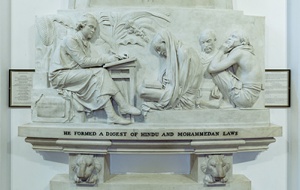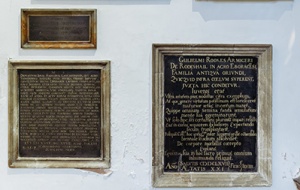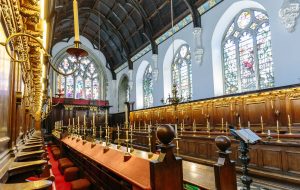 Work started on our Chapel in 1639, as part of the building of our south range. We commissioned for it a set of painted windows from Abraham van Linge, a Dutch artist who had produced splendid windows in various places in Oxford, including Lincoln, Queen’s, and Christ Church. A contract was drawn up with van Linge to produce eight side windows and one grand east window.
Work started on our Chapel in 1639, as part of the building of our south range. We commissioned for it a set of painted windows from Abraham van Linge, a Dutch artist who had produced splendid windows in various places in Oxford, including Lincoln, Queen’s, and Christ Church. A contract was drawn up with van Linge to produce eight side windows and one grand east window.
The side windows were finished in 1641, but before van Linge could begin the east window, the English Civil War broke out, and all work had to be suspended, so that his project remained unfinished. The windows which van Linge had managed to complete were all put into storage, and nothing more happened for twenty years. All we know is that in 1651/2 the College bought a new lock “to lock up the new Chappell glasse in the storehouse”.
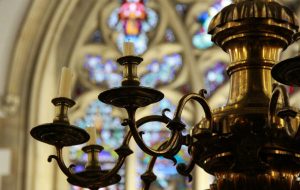 In the 1660s, after the Restoration of the Monarchy, work resumed on the Chapel: the windows were now brought out of storage, and a roof and furnishings built. The Chapel was consecrated on 20 March 1666. Find out more about the Chapel windows below.
In the 1660s, after the Restoration of the Monarchy, work resumed on the Chapel: the windows were now brought out of storage, and a roof and furnishings built. The Chapel was consecrated on 20 March 1666. Find out more about the Chapel windows below.
A few changes were made in the Chapel shortly after its completion: an east window was installed in the 1680s, and in 1694 a splendid screen separating the Chapel from the Antechapel was installed. It was designed by Robert Barker, a London joiner.
It was the Victorians, however, who changed the Chapel the most. In the early 1860s, Sir George Gilbert Scott, fresh from having designed our Library, was commissioned to refurbish the Chapel. He installed a new roof and east window (both still in place), as well as a new window at the east end of the south side, but he also installed a stone reredos at the east end, totally out of character with the rest of the Chapel. Fortunately, in 1843, just before Scott set to work, the pioneering photographer William Fox Talbot took a photograph of the east end of the Chapel from the Master’s Garden which shows the original seventeenth-century window with its rather curious tracery. It can be seen at foxtalbot.bodleian.ox.ac.uk
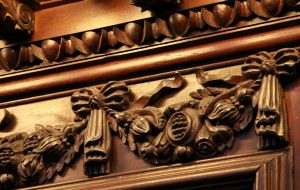 Scott’s east end was covered up by the original wooden reredos, and some red curtains, in the 1920s, and remains an object lesson in how one generation can completely misunderstand an earlier one.
Scott’s east end was covered up by the original wooden reredos, and some red curtains, in the 1920s, and remains an object lesson in how one generation can completely misunderstand an earlier one.
The Chapel was originally built without an organ; it was not until 1863 that one was installed. The current organ was created in 1955.
Chapel Windows
The Organs of Univ
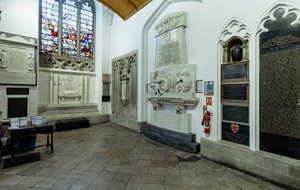 Monuments in the Antechapel
Monuments in the Antechapel
Univ’s Chapel is typical of Oxford and Cambridge in having several memorials to its former members in its Antechapel. Some memorials relate to people who are buried here (at least four Masters lie under the High Altar, for example), but others are memorials to people buried elsewhere.
The north, south and west walls all feature monuments, find out more below:

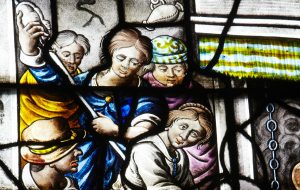 Abraham van Linge prepared eight windows for the sides of Univ’s Chapel. They were his last work in Oxford, and, in many people’s opinion, also his finest.
Abraham van Linge prepared eight windows for the sides of Univ’s Chapel. They were his last work in Oxford, and, in many people’s opinion, also his finest.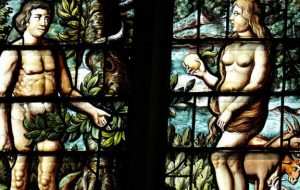 The choice of subjects was evidently carefully thought through. The two New Testament images, which were intended to be seen together, would have reminded visitors that they were now about to enter a Chapel, with their messages of how to receive God’s word and to behave in his holy place.
The choice of subjects was evidently carefully thought through. The two New Testament images, which were intended to be seen together, would have reminded visitors that they were now about to enter a Chapel, with their messages of how to receive God’s word and to behave in his holy place.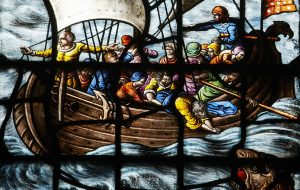 The windows regularly include several parts of the same story: in window (8), for example, Jonah is seen in the foreground emerging from the whale, but in the background of the same picture he is seen being thrown out into the sea with the whale ready and eager to swallow him up. One window, number (2), is unique in including two quite different stories. In the foreground are Adam and Eve contemplating their fallen state, but in the background Abraham is seen entertaining two angels.
The windows regularly include several parts of the same story: in window (8), for example, Jonah is seen in the foreground emerging from the whale, but in the background of the same picture he is seen being thrown out into the sea with the whale ready and eager to swallow him up. One window, number (2), is unique in including two quite different stories. In the foreground are Adam and Eve contemplating their fallen state, but in the background Abraham is seen entertaining two angels.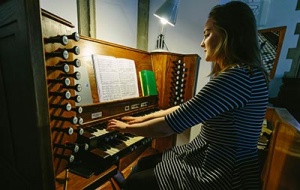 The chapel was originally built without an organ, and was consecrated in 1666. It was some two hundred years later, in 1866, that a small one-manual and pedal organ was built by the Suffolk-based company J.W. Walker Ltd and installed on the North side of the chapel, where the ‘loft’ for the organ console now resides. In 1955, Walker rebuilt the organ with two manuals and pedals, constructing a new case on the West wall, and significantly expanding the resources of the instrument, providing an enclosed Swell division, as well as a then state-of‑the‑art detached console and associated playing aids.
The chapel was originally built without an organ, and was consecrated in 1666. It was some two hundred years later, in 1866, that a small one-manual and pedal organ was built by the Suffolk-based company J.W. Walker Ltd and installed on the North side of the chapel, where the ‘loft’ for the organ console now resides. In 1955, Walker rebuilt the organ with two manuals and pedals, constructing a new case on the West wall, and significantly expanding the resources of the instrument, providing an enclosed Swell division, as well as a then state-of‑the‑art detached console and associated playing aids.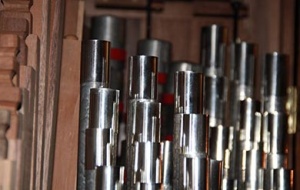 Walker also kept almost all of the pipework from the previous instrument, although the new Swell division had more of a neo-Baroque flavour, reflecting an early stage in the revival of the performance of baroque organ music. The Swell division, because space was at a premium, relied on the principle of extension, whereby extra octaves of pipes could be added to just a few ranks to give an apparently far greater number of stops.
Walker also kept almost all of the pipework from the previous instrument, although the new Swell division had more of a neo-Baroque flavour, reflecting an early stage in the revival of the performance of baroque organ music. The Swell division, because space was at a premium, relied on the principle of extension, whereby extra octaves of pipes could be added to just a few ranks to give an apparently far greater number of stops.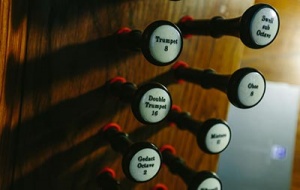 The 1955 Walker instrument gave many years of faithful service, but eventually failing electrical components both in the console and the organ itself, many of which were impossible to reach for repair or replacement, necessitated the rebuilding of the instrument. In 2012, the Leicestershire-based firm Peter Collins Ltd, were commissioned to rebuild the instrument within the existing Walker case. Where possible, original pipework (including the six stops in the Great division from the 1866 organ) has been retained, but the opportunity has also been taken to make some tonal alterations – in particular to try to better match the tonal style of the Great and Swell, as well as to provide tonal colours more suited for the instrument’s main role – the accompaniment of the college’s chapel choir at the weekly Choral Evensong. The guts of the organ – the blower, windchests, swell enclosure, the frame and console (with a full complement of modern playing aids), are all new, and will provide many generations of organ scholars with a versatile and exciting instrument for performance of a wide range of the organ literature, as well as choral accompaniment and as a teaching instrument.
The 1955 Walker instrument gave many years of faithful service, but eventually failing electrical components both in the console and the organ itself, many of which were impossible to reach for repair or replacement, necessitated the rebuilding of the instrument. In 2012, the Leicestershire-based firm Peter Collins Ltd, were commissioned to rebuild the instrument within the existing Walker case. Where possible, original pipework (including the six stops in the Great division from the 1866 organ) has been retained, but the opportunity has also been taken to make some tonal alterations – in particular to try to better match the tonal style of the Great and Swell, as well as to provide tonal colours more suited for the instrument’s main role – the accompaniment of the college’s chapel choir at the weekly Choral Evensong. The guts of the organ – the blower, windchests, swell enclosure, the frame and console (with a full complement of modern playing aids), are all new, and will provide many generations of organ scholars with a versatile and exciting instrument for performance of a wide range of the organ literature, as well as choral accompaniment and as a teaching instrument.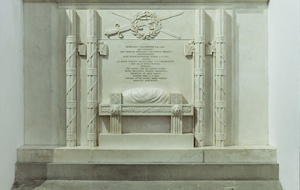 To the left at the top, is a marble memorial to Matthew Rolleston, a Fellow of Univ who died in 1817 aged only 30. This monument was given by a former pupil and is one of four in this Chapel created by the great neoclassical sculptor John Flaxman.
To the left at the top, is a marble memorial to Matthew Rolleston, a Fellow of Univ who died in 1817 aged only 30. This monument was given by a former pupil and is one of four in this Chapel created by the great neoclassical sculptor John Flaxman.